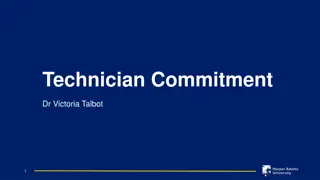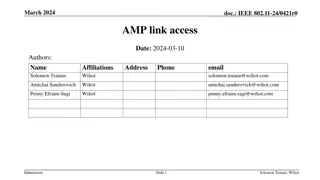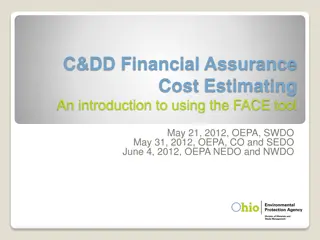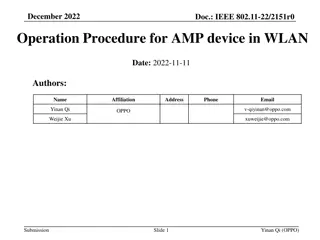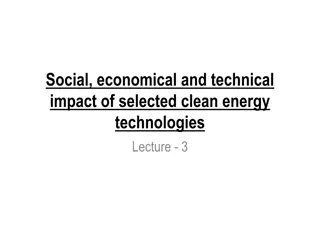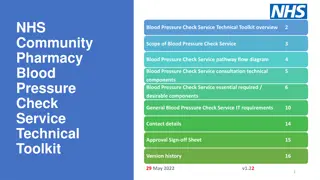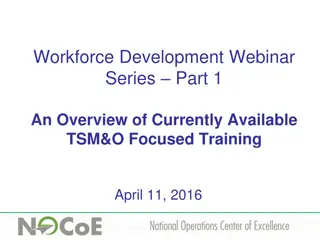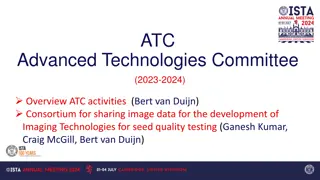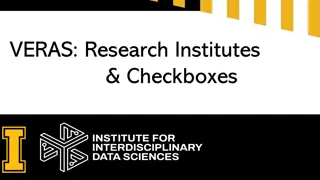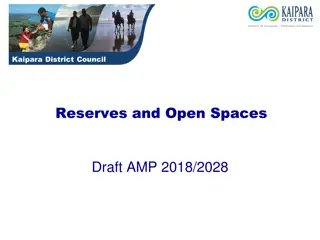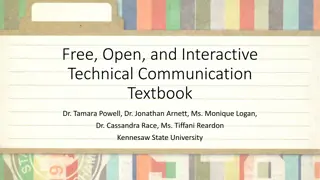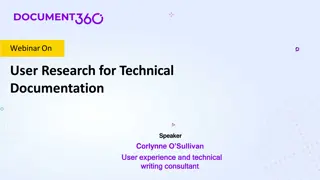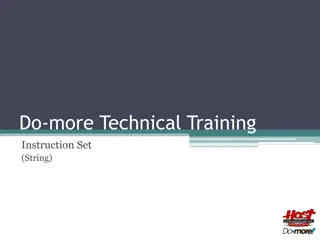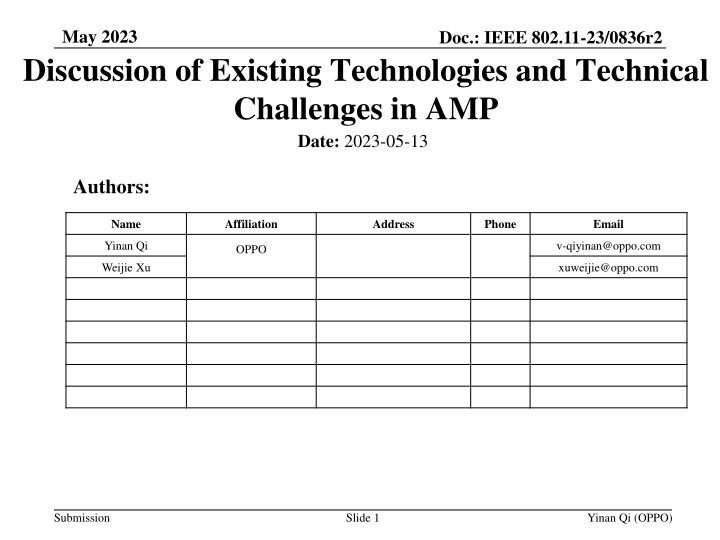
Technical Insights into IEEE 802.11-23/0836r2 for Advanced WLAN Development
Discover key discussions on existing technologies and technical challenges in Advanced WLANs based on IEEE 802.11-23/0836r2. Topics include considerations on DL receiver design, MAC mechanisms, uplink transmission, and security in the AMP ecosystem. Explore details on ultra-low complexity, power consumption specifications, and frequency bands for optimal performance. Gain insights into design references for AMP DL receivers, waveform methodologies, and regional regulation alignments for efficient data transmission.
Download Presentation

Please find below an Image/Link to download the presentation.
The content on the website is provided AS IS for your information and personal use only. It may not be sold, licensed, or shared on other websites without obtaining consent from the author. If you encounter any issues during the download, it is possible that the publisher has removed the file from their server.
You are allowed to download the files provided on this website for personal or commercial use, subject to the condition that they are used lawfully. All files are the property of their respective owners.
The content on the website is provided AS IS for your information and personal use only. It may not be sold, licensed, or shared on other websites without obtaining consent from the author.
E N D
Presentation Transcript
May 2023 Doc.: IEEE 802.11-23/0836r2 Discussion of Existing Technologies and Technical Challenges in AMP Date: 2023-05-13 Authors: Name Affiliation Address Phone Email Yinan Qi v-qiyinan@oppo.com OPPO Weijie Xu xuweijie@oppo.com Submission Slide 1 Yinan Qi (OPPO)
Doc.: IEEE 802.11-23/0836r2 May 2023 Outline Reference for AMP : 802.11ba Considerations on AMP DL receiver Reference for AMP: existing MAC mechanism Considerations on AMP MAC Considerations on AMP uplink transmission Summaryof Candidate frequency bands for AMP Security Submission Slide 2 Yinan Qi (OPPO)
May 2023 Doc.: IEEE 802.11-23/0836r2 Reference for AMP DL PHY: 802.11ba In 802.11ba, WUR with ultra-low complexity and ultra-low power consumption(< 1mw) has been specified. For WUR, MC-OOK spanning 4MHz is specified. - With OOK, the complexity and power consumption of the receiver can be reduced. - MC-OOK provide the flexibility of adjusting the DL transmission power (considering the PSD requirement) even at the same symbol rate. - Manchester coding is used to ease the receiver implementation - 4MHz is a good compromise of the complexity and the DL transmission power - For WUR PPDU, a legacy preamble part is added before the WUR portion. The main function of WUR is for transmission of control signalling - wake up the main radio if there is buffered data, or, - Inform the critical information update Two data rate is supported: LDR: 62.5Kbps, HDR: 250kbps. The receiver sensitivity of WUR shall be lower than -82dBm. Submission Slide 3 Yinan Qi (OPPO)
May 2023 Doc.: IEEE 802.11-23/0836r2 Considerations on AMP DL receiver(1) For AMP device, design of WUR can be a good reference for AMP DL receiver - The power consumption of WUR is expected to be lower than 1mw, which matches with the requirement of AMP device For AMP device, the ultra-low power DL receiver needs to work by itself. It itself is the main radio for AMP devices. - It shall be able to complete all the possible DL operation/transmission. - Such as: Scanning, time/frequency synchronization, association, security establishment, DL frame acquisition and data transmission. With same duty cycle, ultra-low power DL receiver can get 100-1000 times power saving compared with the existing devices (100mw is assumed for legacy DL receiver). Submission Slide 4 Yinan Qi (OPPO)
May 2023 Doc.: IEEE 802.11-23/0836r2 Considerations on AMP DL receiver(2) If operate at 2.4GHz, most of the existing WUR PHY design can be directly reused. If operate at sub-1 GHz, the methodology can be reused, with adjusted numerologies. - The waveform, OOK, etc - The sub-carrier spacing, OOK symbol length, the bandwidth of the OOK signal. - The Channelization needs to be aligned with the regional regulation, e.g., 20 channels with 250kHz channel bandwidth each@920-925MHz in China For data transmission, frequency hopping also needs to be considered (e.g. the maximum dwell time within each channel is 2s @920- 925MHz in China). Submission Slide 5 Yinan Qi (OPPO)
May 2023 Doc.: IEEE 802.11-23/0836r2 Considerations on AMP uplink transmission(1)-Active transmitter Waveform: OOK can be baseline since OOK is already supported in DL. FSK or PSK can also be considered. The power consumption and the complexity needs to be considered when we choose the waveform for uplink transmission The power includes the output power, the transmitter consumed power (when considering the transmitter efficiency) , the power consumed by oscillator and the baseband (coding and modulation). Active transmitter is feasible for AMP UL transmission Transmission power in a range of -20dbm~-10 dBm. The key issue is how to get RF frequency for uplink transmission - Legacy crystal oscillator is not preferred due to its power consumption - Low complexity and low power frequency generation (10x uw~100x uw) shall be studied for AMP device With same duty cycle, the peak power consumption for AMP can be 100x times lower than that of the existing devices (200mw is assumed for legacy transmitter). Submission Slide 6 Yinan Qi (OPPO)
May 2023 Doc.: IEEE 802.11-23/0836r2 Considerations on AMP uplink transmission(2)-backscatter Backscattering Lower power consumption (x uw~10x uw) can be expected than active transmitter, due to no need of the oscillator However, there is self-interference issue for the AP, especially when the incident carrier and the backscattering signal are in the same channel - Even for difference channel, the existing ACR requirement is difficult to be met for mono-static AP Backscattering on different channel with the incident carrier and biostatic deployment of the AP can be considered. Submission Slide 7 Yinan Qi (OPPO)
May 2023 Doc.: IEEE 802.11-23/0836r2 Reference for AMP: existing MAC mechanisms Many MAC mechanism can be used as the reference for AMP MAC - AID extension - RAW - Shortened MAC headers/TIM slicing - NDP frames(NDP paging) - Normal/short beacons - RID - TWT - PS-Poll - Doze state extension - EoL - TXOP sharing Submission Slide 8 Yinan Qi (OPPO)
May 2023 Doc.: IEEE 802.11-23/0836r2 Considerations on AMP MAC(1) It can be considered to further reduce the MAC overhead for AMP - Due to its lower data rate (e.g. with narrow bandwidth) - Reduce the transmission time duration for power saving Legacy MAC header and short MAC header It can be considered to try to reduce the time during which the AMP device is in awake state for power saving It can be considered to reduce the unnecessary interaction between the AP and AMP devices for power saving Submission Slide 9 Yinan Qi (OPPO)
May 2023 Doc.: IEEE 802.11-23/0836r2 Considerations on AMP MAC(2) Consider to relax the requirement of co-existence for AMP device - The AP can help to handle the co-existence - The AP is able to send legacy preamble and share the TXOP to the AMP devices - Also consider the ultra-low transmission power from the AMP device ( e.g. less than -25dBm for backscattering or less than -10dBm for active transmission) - In sub-1 GHz, there is no legacy device, expect 802.11ah device deployed in some countries. Can we allow the AMP device s PPDU transmission without a legacy preamble part for the following 2 cases: 1) Green field without any legacy device. 2) There is legacy 802.11 ah device, but restrict the maximum power from AMP devices to lower than -10 dBm. TXOP s h a rin g AMP AMP d e vice d e vice 802 .11 a h 802 .11 a h STA STA AP2 AP2 AP1 AP1 Co-existence of AMP device and 802.11ah device @sub-1 GHz Submission Slide 10 Yinan Qi (OPPO)
February 2023 Doc.: IEEE 802.11-22/1960r5 Summaryof Candidate frequency bands for AMP Frequency band Maximum RF power Sub-1 GHz 2.4GHz 33dBm ERP@920-925MHz @CN 30+6 = 36 EIRP dBm @902~928@US 29.14 dBm EIRP@865-867 EU for RFID 35.15dbM EIRP@865-867 EU for RFID for antennas having a beamwidth 90 To be specified 20dBm@EU/CN 27dBm@CN for high Ant gain(>10dBi) 30+6 = 36dBm@US Re-use WUR: -82dBm DL Receiver sensitivity PSD No limitation 10dBm/1MHz@CN and EU 17dBm/1MHz@CN for high Ant gain(>10dBi) OFDM: 20MHz WUR: 4MHz Channel bandwidth 250KHz @CN 200K-250KHz @EU 1MHz @US Submission Slide 11 Weijie Xu (OPPO)
February 2023 Doc.: IEEE 802.11-22/1960r5 On security For a many AMP use cases, user privacy needs to be protected. AES 128 level security is used in current 802.11 WiFi. It needs to be further check whether AMP device is able to support AES-128 The most important issue is the power consumption. Contributions are called for to show the power consumption of AES- 128. Submission Slide 12 Weijie Xu (OPPO)
Doc.: IEEE 802.11-23/0836r2 May 2023 Summary In this presentation, several important reference for AMP DL receiver and MAC are summarized. Based on that, the consideration on AMP DL receiver, MAC, uplink transmitter, candidate frequency band and security are present. Submission Slide 13 Yinan Qi (OPPO)
Doc.: IEEE 802.11-23/0836r2 May 2023 Reference 1. 2. http://www.srrc.org.cn/article29539.aspx https://www.etsi.org/deliver/etsi_en/302200_302299/302208/03.03.01_60/en_302208 v030301p.pdf https://www.ecfr.gov/current/title-47/chapter-I/subchapter-A/part-15/subpart- C/subject-group-ECFR2f2e5828339709e/section-15.247 IEEE 802.11-23/0436r0 Technical Report on support of AMP IoT devices in WLAN 3. 4. Submission Slide 14 Yinan Qi (OPPO)






